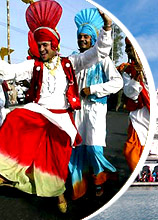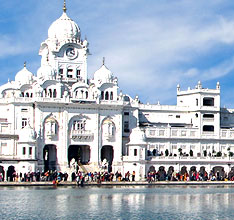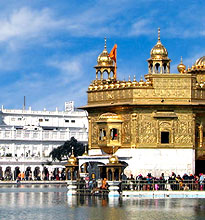 The city of Kapurthala abounds in several historic monuments, which attracts tourists across the globe. Let is explore these tourist places in detail.
The city of Kapurthala abounds in several historic monuments, which attracts tourists across the globe. Let is explore these tourist places in detail.Sainik School (Jagatjit Palace)
The Jagatjit Palace, presently called Sainik School, was formerly the palace of Maharajah Jagatjit Singh of Kapurthala. It was designed by the French Architect M. Marcel and the construction of the building was completed in 1908. It is spread over a total area of 200 acres. The roofs of the palace have been made in the 'beaux-art’ style of the 19th century. Of them, the most impressive is the Mansard Roof, with a double slope and oeil-de-boeuf windows, like those of the Louvre. Durbar Hall is the prime attraction here, which abounds in samples of French art and architecture. Today, the palace has been converted into Sainik School.
Elysee Palace
Built in 1862, by Kanwar Bikrama Singh, the Elysee Palace has an imposing and elegant facade. Today, the palace has been converted into MGN School of Kapurthala.
Moorish Mosque
Built in 1930, by the French architect Monsieur M Manteux, the mosque is a famous replica of the Qutbya Mosque of Marakesh, Morocco. It was built during the reign of Maharaja Jagatjit Singh. It is a national monument, under the Archaeological Survey of India. The inner dome of the mosque has designs of the Mayo School of Arts, Lahore.
Jagatjit Club
It is a historical building situated on the main Mall Road. Over the years, it has housed a church, a cinema hall and now the local club. Its Grecian columns and bell tower are outstanding testimonies of great art. Its design loosely resembles the Acropolis of Athens and features the Coat of Arms of the erstwhile ruling family of Kapurthala, with their royal motto "Pro Rege et Patria" (For King and Country) on its pediment.
Shalimar Gardens
Shalimar Garden is located in the centre of the town and provides a relief from the daily worries of life. The garden has Shahi Samadhs (royal cenotaphs), which emphasize the traditions of its ruling dynasty. Nearby, there is a grand structure built in 1880, which houses the samadhis of Maharajaas Kharak Singh, Jagatjit Singh and Paramjit Singh. The gardens also contain 'Baradari’ - a historical building that served as the meeting point of Maharaja Ranjit Singh and Maharaja Fateh Singh. The entrance gate is splendid and the gardens have a pond, a park and a library. Every year, Basant Panchi Mela is organized here.
Panch Mandir
Panch Mandir was built by Fateh Singh Ahluwaliah, the founder of the Kapurthala. The main dome in the center is surrounded by five small temples dedicated to different deities. An extraordinary feature of the temple is that from the entry door, one can have a view of all the five Idols and pay obeisance to all.
The State Gurdwara
The large and imposing red sandstone building (now painted white) of the State Gurudwara was consecrated in 1915. Built in the Indo-Saracenic style, it has vast expanses of marble, haloed by the feet of hundreds of devotees.
Gurdwara Ber Sahib
Gurdwara Ber Sahib is located in Sultanpur Lodhi, in the district of Kapurthala. It is revered as the site where Guru Nanak spent 14 years of his life. Here, Guru Nanak got enlightenment, while taking bath in the river Kali Bein and created 'Sukhmani Sahib’. The place derives its name from a Ber tree (Zizyphus Jujuba), said to be planted by Guru Nanak himself, under which he first uttered the Mool Mantra or the "Sacred Word or Revelation" of Sikhism.
Pushpa Gujral Science City
Pushpa Gujral Science City is the biggest project of its kind in northern India. It has been set up in 72 acres of land, on the Jalandhar-Kapurthala Road. It was built with the aim to educate the masses about the wonders of science in the most pleasant and entertaining manner.
The Court Complex
The present District Courts are located in the once-magnificent complex of what was the former Kapurthala State Durbar Hall. It was constructed in 1889 and was built in an impressive style with red bricks, stylized domes and stone lattice work. The door and window frames are in the Islamic style.
The War Memorial
Built in 1923, the building is made out of red sandstone and is an outstanding example of Indo-Saracenic style of architecture. The striking attraction is a bronze statue of a soldier of the Kapurthala State Forces.
The Maharaja's Library
The library consists of a grand collection of artifacts, including a mechanical clock and a rare orchestra with an automatic tune player.
Kanjli Wetland
It is located on the western Bein rivulet, at the outskirts of the city. It is a very popular site for bird watching and boating. An enormous project is currently being undertaken here, to develop it into a destination for bird watching, replete with modern day facilities.
Mausoleum of Peer Yau-udin Sahib (Peer Chaudhri)
The Muslim Saint, Peer Yau-udin Sahib was the benefactor of the Royal House of Kapurthala. His "Dera" or residence used to be in the forecourt of the City Palace of the then rulers. When the court was moved to the new palace, Peer Sahib was given this piece of land for use, by Maharaja Jagatjit Singh i(n 1902), not far from the new palace. To this day, devotees of all persuasions throng the mausoleum with offerings of oil & kind.
Sultanpur Lodhi
The picturesque township has a number of smaller gurdwaras, all associated with the life of Guru Nanak Dev Ji. Two of them, apart from the main Gurdwara Ber Sahib, are Gurdwara Hat Sahib and Gurdwara Watta Sahib.











